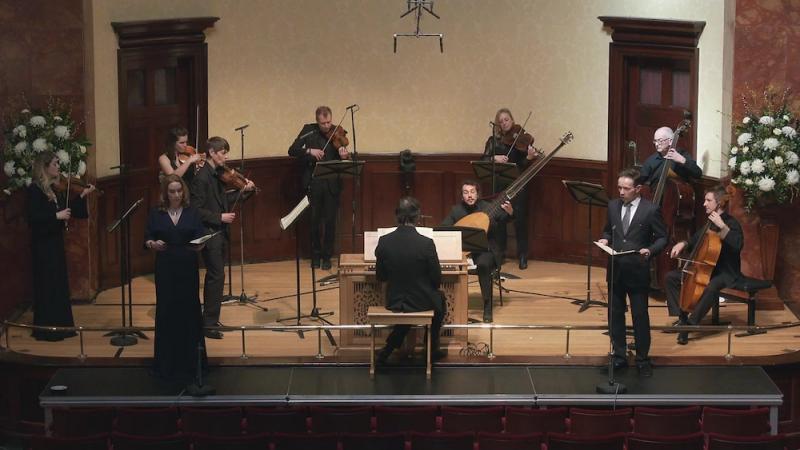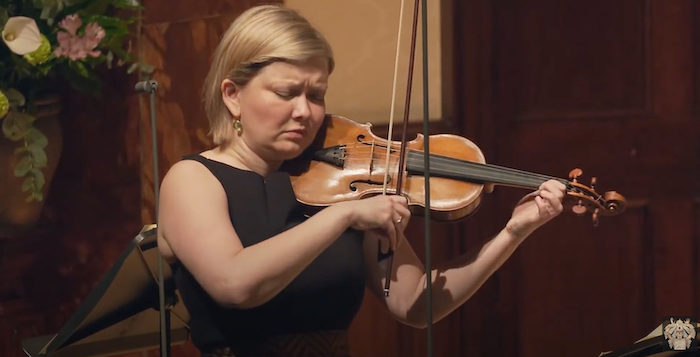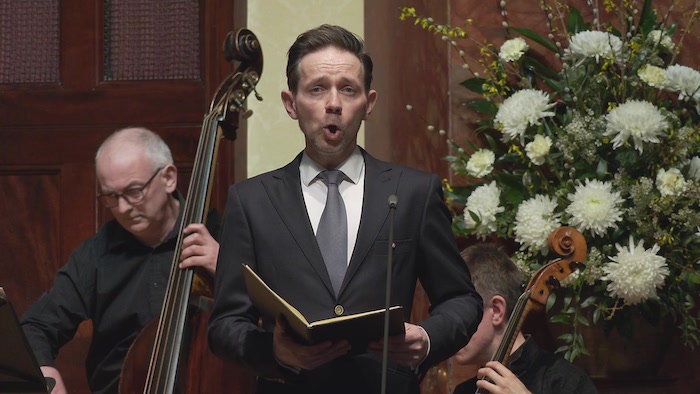Ibragimova, Davies, Sampson, Arcangelo, Wigmore Hall online review – baroque masterpieces played with verve | reviews, news & interviews
Ibragimova, Davies, Sampson, Arcangelo, Wigmore Hall online review – baroque masterpieces played with verve
Ibragimova, Davies, Sampson, Arcangelo, Wigmore Hall online review – baroque masterpieces played with verve
Violin concertos that bustle contrast with a dark and moving Stabat Mater

The baroque music ensemble Arcangelo have been around since 2010 but I hadn’t heard them before this pair of concerts streamed from Wigmore Hall in the last week. But what I heard has certainly encouraged me to seek out more – and they have quickly built up a large discography ready to be tucked into.
The Wigmore Hall has been a particular oasis of music during the last year, both in its streaming and in the restricted live-audience concerts it staged later last year (the last of which also featured Iestyn Davies and Arcangelo). The presentation has come on dramatically since the early days of two fixed cameras: the production of both these concerts was of a decent quality, edited to offer sufficient variety while avoiding fussiness. There was also informative radio-style hosting by Kate Romano and Michael White, although these didn’t entirely make up for the disappointing fact there was no documentation of the players’ names. So only some online detective work, and his startling likeness to the character of Toulouse-Lautrec in the film Moulin Rouge, enabled me to identify the vibrant and expressive theorbo player as Sergio Bucheli. I would have liked to be able to name more names in what follows.
The only Arcangelo player listed was the founder and keyboardist Jonathan Cohen, although he was very much just “one of the gang” in his stage presence. He led the violin concerto recital from the harpsichord and the Pergolesi from the chamber organ with a style that was good-natured and collegiate, only occasionally conducting, mostly relying on almost constant eye contact with the ensemble. The players were on period instruments – including Ibragmimova (pictured below), who is an unusual virtuoso equally at home in big warhorse concertos and with the lighter baroque bow.  Her concert began in a barrage of notes in Vivaldi’s concerto “L’Inquietitudine”, the energy palpable, the forward momentum constant. This was not refined playing offering abstract delights, this was in-your-face, gutsy playing, offering thrills and leaps and high trapeze artistry. There was more Vivaldi later in one of his concertos for four violins (op.3 no.10), later arranged for keyboards by J.S.Bach. This was more bustling music, the interplay between the soloists capturing the back and forth of a cocktail party conversation.
Her concert began in a barrage of notes in Vivaldi’s concerto “L’Inquietitudine”, the energy palpable, the forward momentum constant. This was not refined playing offering abstract delights, this was in-your-face, gutsy playing, offering thrills and leaps and high trapeze artistry. There was more Vivaldi later in one of his concertos for four violins (op.3 no.10), later arranged for keyboards by J.S.Bach. This was more bustling music, the interplay between the soloists capturing the back and forth of a cocktail party conversation.
There was Bach as well: his extraordinary Sonata for Violin and Continuo BWV 1023, that starts with a fluid, hypnotic line on the violin building into the most fleet passagework from Ibragimova. Throughout, her playing had infinite care but didn’t tread too carefully. Hers was completely whole-hearted playing, nowhere more so than in the stunning slow movement of the A major Violin Concerto (BWV 1055). Ibragimova found a dark-hued sound but never slipped into bleakness, as the elaborate lines wove around each other. The concerto ends with an enjoyable gallop, but it’s the haunting slow movement that remains in the memory.
This is also somewhat the case with Pergolesi’s Stabat Mater. He was only 26, and dying himself, when he wrote it and it has been criticised at times for its operatic, perhaps even frivolous, approach to the most tragic of Christian texts. The frantically repeated “amens” which the piece ends with never feel to me entirely in keeping with what goes before. But despite reservations about the ending it remains a masterpiece in which the leavening of the tragedy offers light and shade where otherwise there would only be shade. There is always a question in the Pergolesi of whether the two voices should blend or be clearly differentiated. The decision here was firmly in favour of the latter, with the cut-crystal countertenor of Iestyn Davies (pictured above) set against the warmth of Carolyn Sampson’s soprano. The piece alternates solo numbers for both with duets, where sometimes the voices work in concert, such as in the sombre “O quam tristis”, and sometimes feeding off their independence, such as in the fugal eighth movement “Fac ut ardeat”. In both these modes both Davies and Sampson showed great awareness of each other and a sense of proportion, keeping it mainly intimate and making the big moments pleasingly sparing. The ensemble accompanied discreetly and tastefully, with no more than a momentary loss of ensemble, and plenty of excellent theorbo work.
There is always a question in the Pergolesi of whether the two voices should blend or be clearly differentiated. The decision here was firmly in favour of the latter, with the cut-crystal countertenor of Iestyn Davies (pictured above) set against the warmth of Carolyn Sampson’s soprano. The piece alternates solo numbers for both with duets, where sometimes the voices work in concert, such as in the sombre “O quam tristis”, and sometimes feeding off their independence, such as in the fugal eighth movement “Fac ut ardeat”. In both these modes both Davies and Sampson showed great awareness of each other and a sense of proportion, keeping it mainly intimate and making the big moments pleasingly sparing. The ensemble accompanied discreetly and tastefully, with no more than a momentary loss of ensemble, and plenty of excellent theorbo work.
The grim tread of the opening movement, with its agonised chains of suspensions, perhaps felt a bit slow, but this was not a problem in “Quae meorebat et dolebat” in which Iestyn Davies’ trills sounded effortless and things zipped along. The highlight of Carolyn Sampson’s singing was in the fifth movement, where here razor-sharp tuning and brilliantly introduced vibrato was masterful. And if the finale doesn’t quite convince it was done here with commitment and seriousness and in those terms it worked.
- Watch on the Wigmore Hall player: Ibragimova concert and Iestyn Davies/Carolyn Sampson concert
- More classical reviews on theartsdesk
rating
Explore topics
Share this article
The future of Arts Journalism
You can stop theartsdesk.com closing!
We urgently need financing to survive. Our fundraising drive has thus far raised £49,000 but we need to reach £100,000 or we will be forced to close. Please contribute here: https://gofund.me/c3f6033d
And if you can forward this information to anyone who might assist, we’d be grateful.

Subscribe to theartsdesk.com
Thank you for continuing to read our work on theartsdesk.com. For unlimited access to every article in its entirety, including our archive of more than 15,000 pieces, we're asking for £5 per month or £40 per year. We feel it's a very good deal, and hope you do too.
To take a subscription now simply click here.
And if you're looking for that extra gift for a friend or family member, why not treat them to a theartsdesk.com gift subscription?
more Classical music
 Anja Mittermüller, Richard Fu, Wigmore Hall review - a glorious hall debut
The Austrian mezzo shines - at the age of 22
Anja Mittermüller, Richard Fu, Wigmore Hall review - a glorious hall debut
The Austrian mezzo shines - at the age of 22
 First Person: clarinettist Oliver Pashley on the new horizons of The Hermes Experiment's latest album
Compositions by members of this unusual quartet feature for the first time
First Person: clarinettist Oliver Pashley on the new horizons of The Hermes Experiment's latest album
Compositions by members of this unusual quartet feature for the first time
 Gesualdo Passione, Les Arts Florissants, Amala Dior Company, Barbican review - inspired collaboration excavates the music's humanity
At times it was like watching an anarchic religious procession
Gesualdo Passione, Les Arts Florissants, Amala Dior Company, Barbican review - inspired collaboration excavates the music's humanity
At times it was like watching an anarchic religious procession
 Classical CDs: Camels, concrete and cabaret
An influential American composer's 90th birthday box, plus British piano concertos and a father-and-son duo
Classical CDs: Camels, concrete and cabaret
An influential American composer's 90th birthday box, plus British piano concertos and a father-and-son duo
 Cockerham, Manchester Camerata, Sheen, Martin Harris Centre, Manchester review - re-enacting the dawn of modernism
Two UK premieres added to three miniatures from a seminal event of January 1914
Cockerham, Manchester Camerata, Sheen, Martin Harris Centre, Manchester review - re-enacting the dawn of modernism
Two UK premieres added to three miniatures from a seminal event of January 1914
 Kempf, Brno Philharmonic, Davies, Bridgewater Hall, Manchester review - European tradition meets American jazz
Bouncing Czechs enjoy their Gershwin and Brubeck alongside Janáček and Dvořák
Kempf, Brno Philharmonic, Davies, Bridgewater Hall, Manchester review - European tradition meets American jazz
Bouncing Czechs enjoy their Gershwin and Brubeck alongside Janáček and Dvořák
 Solomon, OAE, Butt, QEH review - daft Biblical whitewashing with great choruses
Even a top soprano and mezzo can’t make this Handel paean wholly convincing
Solomon, OAE, Butt, QEH review - daft Biblical whitewashing with great choruses
Even a top soprano and mezzo can’t make this Handel paean wholly convincing
 Two-Piano Gala, Kings Place review - shining constellations
London Piano Festival curators and illustrious friends entertain and enlighten
Two-Piano Gala, Kings Place review - shining constellations
London Piano Festival curators and illustrious friends entertain and enlighten
 Echo Vocal Ensemble, Latto, Union Chapel review - eclectic choral programme garlanded with dance
Beautiful singing at the heart of an imaginative and stylistically varied concert
Echo Vocal Ensemble, Latto, Union Chapel review - eclectic choral programme garlanded with dance
Beautiful singing at the heart of an imaginative and stylistically varied concert
 Scott, Irish Baroque Orchestra, Whelan, RIAM, Dublin review - towards a Mozart masterpiece
Characteristic joy and enlightenment from this team, but a valveless horn brings problems
Scott, Irish Baroque Orchestra, Whelan, RIAM, Dublin review - towards a Mozart masterpiece
Characteristic joy and enlightenment from this team, but a valveless horn brings problems
 Classical CDs: Voice flutes, flugelhorns and froth
Baroque sonatas, English orchestral music and an emotionally-charged vocal recital
Classical CDs: Voice flutes, flugelhorns and froth
Baroque sonatas, English orchestral music and an emotionally-charged vocal recital

Add comment